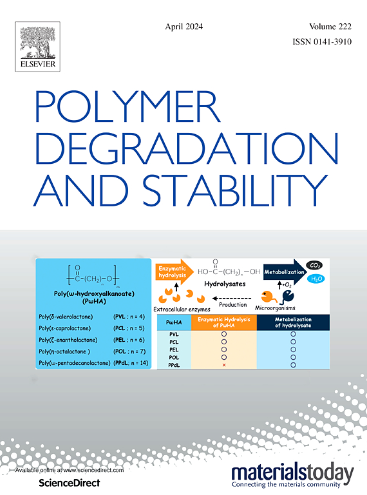Construction of rare earth-based multi-dimensional architectures for high-performance flame-retardant epoxy composites
IF 7.4
2区 化学
Q1 POLYMER SCIENCE
引用次数: 0
Abstract
Flame retardant modification of Epoxy resin remains a thorny challenge that needs further research. Hence, considering the chemical and physical properties between nanomaterials and rare earth elements, this study integrated CeO2-doped La(OH)3 nanorods (CL) and MoS2 nanosheets via electrostatic interaction forces, and then a novel rare earth based hybrid with multi-dimensional architectures, CLMP (CeO2@La(OH)3@MoS2@PPy), was obtained by wrapping PPy on the surface of CLM using interfacial engineering strategy. The CLMP not only exhibited well dispersion and interfacial compatibility within the epoxy resin (EP) matrix, but also enhanced the thermal stability, flame retardancy and mechanical properties. With the addition of 2 wt % CLMP hybrids, the peak heat release rate (PHRR), total heat release (THR), peak smoke production rate (PSPR), and total smoke production (TSP) of EP composites were decreased by 41.7 %, 34.7 %, 46.2 %, and 38.9 %, respectively. Subsequently, the amount of carbon residue for EP/CLMP 2.0 composites increased to 30.0 % compared with pure EP, demonstrating improved flame resistance. Furthermore, EP/CLMP 2.0 composites exhibited excellent mechanical properties, resulting the increases of 109.8 % and 45.5 % in the tensile and flexural strength. The flame retardant and mechanical reinforcement mechanisms were proposed. In simple terms, the rare earth-based multi-dimensional architectures designed in this work establishes a promising strategy for achieving the balance between the fire resistance and mechanical performance.
高性能阻燃环氧复合材料稀土基多维结构的构建
环氧树脂的阻燃改性仍然是一个棘手的挑战,需要进一步的研究。因此,考虑到纳米材料与稀土元素之间的化学和物理性质,本研究通过静电相互作用将ceo2掺杂的La(OH)3纳米棒(CL)和MoS2纳米片集成在一起,然后采用界面工程策略将PPy包裹在CLM表面,获得了一种具有多维结构的新型稀土杂化材料CLMP (CeO2@La(OH)3@MoS2@PPy)。CLMP不仅在环氧树脂(EP)基体中表现出良好的分散性和界面相容性,而且还提高了材料的热稳定性、阻燃性和力学性能。添加2 wt %的CLMP后,EP复合材料的峰值放热率(PHRR)、总放热率(THR)、峰值产烟率(PSPR)和总产烟率(TSP)分别降低了41.7%、34.7%、46.2%和38.9%。随后,与纯EP相比,EP/CLMP 2.0复合材料的残碳量增加到30.0%,阻燃性得到改善。此外,EP/CLMP 2.0复合材料表现出优异的力学性能,拉伸和弯曲强度分别提高了109.8%和45.5%。提出了阻燃机理和机械加固机理。简而言之,本工作中设计的基于稀土的多维结构为实现耐火性和机械性能之间的平衡建立了一个有前途的策略。
本文章由计算机程序翻译,如有差异,请以英文原文为准。
求助全文
约1分钟内获得全文
求助全文
来源期刊

Polymer Degradation and Stability
化学-高分子科学
CiteScore
10.10
自引率
10.20%
发文量
325
审稿时长
23 days
期刊介绍:
Polymer Degradation and Stability deals with the degradation reactions and their control which are a major preoccupation of practitioners of the many and diverse aspects of modern polymer technology.
Deteriorative reactions occur during processing, when polymers are subjected to heat, oxygen and mechanical stress, and during the useful life of the materials when oxygen and sunlight are the most important degradative agencies. In more specialised applications, degradation may be induced by high energy radiation, ozone, atmospheric pollutants, mechanical stress, biological action, hydrolysis and many other influences. The mechanisms of these reactions and stabilisation processes must be understood if the technology and application of polymers are to continue to advance. The reporting of investigations of this kind is therefore a major function of this journal.
However there are also new developments in polymer technology in which degradation processes find positive applications. For example, photodegradable plastics are now available, the recycling of polymeric products will become increasingly important, degradation and combustion studies are involved in the definition of the fire hazards which are associated with polymeric materials and the microelectronics industry is vitally dependent upon polymer degradation in the manufacture of its circuitry. Polymer properties may also be improved by processes like curing and grafting, the chemistry of which can be closely related to that which causes physical deterioration in other circumstances.
 求助内容:
求助内容: 应助结果提醒方式:
应助结果提醒方式:


